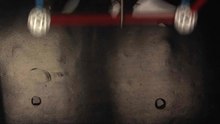Notes for class-11, Physics
Surface tension
Surface tension is the elastic tendency of a fluid surface which makes it acquire the least surface areapossible. Surface tension allows insects (e.g. water striders), usually denser than water, to float and stride on a water surface.
At liquid–air interfaces, surface tension results from the greater attraction of liquid molecules to each other (due to cohesion) than to the molecules in the air (due to adhesion). The net effect is an inward force at its surface that causes the liquid to behave as if its surface were covered with a stretched elastic membrane. Thus, the surface becomes under tension from the imbalanced forces, which is probably where the term "surface tension" came from.[1] Because of the relatively high attraction of water molecules for each other through a web of hydrogen bonds, water has a higher surface tension (72.8 millinewtons per meter at 20 °C) compared to that of most other liquids. Surface tension is an important factor in the phenomenon of capillarity.
Surface tension has the dimension of force per unit length, or of energy per unit area. The two are equivalent, but when referring to energy per unit of area, it is common to use the term surface energy, which is a more general term in the sense that it applies also to solids.
Here is the link for notes:
Watch this video for you motivation, hope you will sure like it..
2) https://www.youtube.com/channel/UCGJ2g2uKYgL25z344PeB2iA
You can follow me on social media for more updates. The links are here:
Facebook: https://www.facebook.com/KsriPravin
Twitter: https://twitter.com/KsriPravin



Comments
Post a Comment